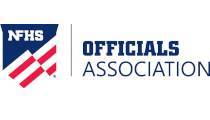
A recent conversation with some non-officiating friends included the question, “How many officials do you have in a game?” I immediately rattled off the answer for our area, “Five in football and three in basketball.” Later that day I realized I had incorrectly answered my friend’s question. In fact, I hadn’t been thinking about the number of officials correctly for many years.
As a high school football official in Indiana, were are allowed only five officials on the field for a varsity game. The reality is, every Friday night we work at least a 14 person crew for a varsity game. It would be tough to work with less than that number, though sometimes we have even more working as part of our officiating crew.
It is easy to identify the five field officials by their striped shirts, baseball caps and yellow flags. Most fans can identify the four members of the chain crew by the orange vests they wear. Less likely for the average fan to notice are the game clock operator, the 25-second clock operator and the scoreboard operator. Let the clock run or not run properly and the fans are screaming at the on-field officials. That’s fine. It is important to know those workers in the press box are part of the officiating crew for that game.
Another part of the crew that most fans never notice is the athletic director and the adult assigned to escort the crew to and from the locker room. That adult may be a local policeman, a school administrator or other adult volunteer but he or she plays an important role on the crew on Friday night.
Maybe we should expand our crew list to include the concession manager that ensures officials have drinks or snacks in their locker room. Is the school employee that prepares the checks for that game night a part of the crew? Probably not, but it is important he or she does the job so the rest of the crew gets paid. What about the public-address announcer, the ball boys and the trainers; are they part of our crew?
Could a high school football game be played without those officials on the field? No. The time can be kept by one of the striped shirts but it changes the experience for the players and fans. Guessing where the line to gain is will not work for anyone.
Any veteran official knows the importance of having good, professional people working to support the on field work. A chain crew that moves too fast or slow hurts the image of everyone on the field. A clock that doesn’t operate properly is cause for concern of all involved. Announcers, escorts and more all contribute to the perception of how the game was managed. Officials must never take these assistants for granted.
In volleyball, a crew includes the official scorer, libero tracker, timer, line judges and the behind the scenes adults assisting the on court crew. In basketball there is a timer, scorer and adult assistants. Baseball and softball include an official scorer, scoreboard operator, grounds crew and adult assistants. Soccer, wrestling, swimming and every other sport requires a team of adults to manage the contest. While those in stripes may feel like the “stars of the show,” officials must always remember that they can’t do their jobs without a support system.
When an official says, “We need to be the best team out there tonight,” they are including each person involved with a whistle, a button, a flag, a water bottle or a key. High school athletics are a partnership. Players, coaches, fans, parents, cheerleaders, school administrators, licensed officials and more are needed to continue to make interscholastic sports the valuable benefit they are.
Mike Hubert
Most Recent Articles
- nfhs news NFHS Learning Center Delivers 25 Millionth Course
- Track & Field/Cross Country article Effective Communication with Athletes and Coaches
- nfhs news Player Equipment Changes Highlight 2025 High School Football Rules Revisions
- Player Equipment Changes Highlight 2025 High School Football Rules Revisions
- nfhs news Judgment Call on Second Contact Eliminated in High School Volleyball






